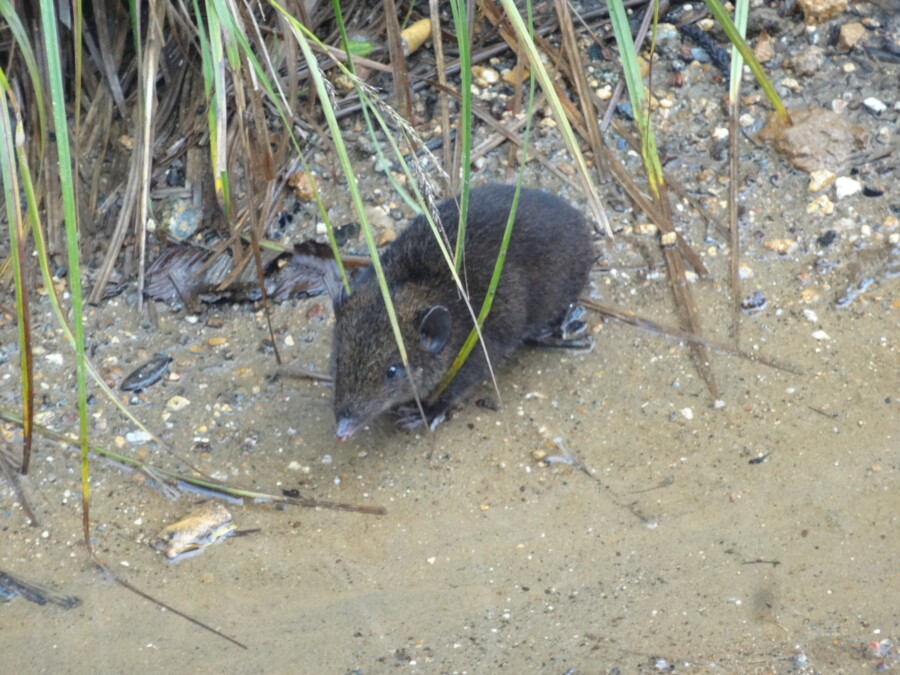Scientists have recently made an exciting discovery in South East Asia – they have found five new species of soft-furred hedgehogs. This discovery required multiple scientific missions to the animals’ tropical forest habitat to study them. Additionally, researchers re-evaluated specimens of the mammals that had been stored in museum collections for many years. Through a detailed study, they found that two of the animals in the museums were previously unknown to science. Furthermore, three other animals, previously categorized as subtypes of one species, were determined to be distinct enough from each other to be recognized as individual species.
Dr. Melissa Hawkins, one of the lead researchers from the Smithsonian National Museum of Natural History, expressed that this discovery highlights the incredible diversity of life on our planet that is still waiting to be revealed. She emphasized that even in well-studied groups like mammals, especially those that live in hard-to-reach habitats, there is still much we do not know. Dr. Hawkins also mentioned that finding animals like these can draw attention to threatened rainforest ecosystems.
The newly discovered species belong to a group of hedgehogs called Hylomys, which are found in South East Asia. Previously, only two species were known, but this discovery brings the total to seven. These small, long-nosed mammals are furry rather than spiny like their more familiar hedgehog relatives. Dr. Arlo Hinckley, also from the Smithsonian National Museum of Natural History, highlighted the importance of this discovery in South East Asia, which has the highest rates of deforestation in the world.
Discovering new species can be challenging, especially when studying small animals that live in dense forests. The researchers found key differences in the genetic codes and physical characteristics, particularly the shape of their heads and teeth. The scientists named one of the newly discovered species Hylomys macarong, which means “vampire” in Vietnamese, due to its particularly long fangs. In addition to studying the animals in the wild, the researchers examined specimens from various natural history collections across Asia, Europe, and the US. Two of the newly discovered species were found in museum collections where they had been stored for several decades.
Dr. Hawkins described the ability of museum curators to “time travel” by looking at specimens in collections. This allowed them to gather enough genetic material to confirm that the three other species, previously categorized as subspecies, were actually biologically distinct. Each Hylomys species appears to inhabit a slightly different habitat, with some found in lowland forests and others at higher altitudes. Dr. Hinckley compared finding these unique animals to the inclusion of a Picasso painting in an art gallery or the discovery of an archaeological site in a city. He emphasized the additional value and potential funding that can come from protecting these important habitats.
The discovery of these five new soft-furred hedgehog species has been published in the Zoological Journal of the Linnean Society. This finding highlights the ongoing exploration and discovery of
Original news source: Five new soft-furred hedgehog species discovered (BBC)
🎧 Listen:
Slow
Normal
Fast
📖 Vocabulary:
| 1 | discovery | The act of finding something for the first time |
| 2 | species | A group of living organisms consisting of similar individuals |
| 3 | missions | Planned operations aimed at achieving a particular goal |
| 4 | habitat | The natural environment in which a particular species lives |
| 5 | specimens | Samples of natural objects, such as animals, plants, or fossils, that are kept for study |
| 6 | categorized | Classified or arranged in specific groups |
| 7 | diversity | The variety of different types of life found on Earth |
| 8 | ecosystems | Communities of living organisms together with their physical surroundings |
| 9 | deforestation | The action of clearing Earth’s forests on a massive scale, often resulting in damage to the quality of the land |
| 10 | genetic | Relating to the genetic constitution of an individual or species |
| 11 | fangs | Long, pointed teeth typically used for biting and tearing food |
| 12 | curators | Individuals responsible for managing and overseeing museum collections |
| 13 | distinct | Clearly separate and different from others |
| 14 | altitudes | The height of an area above sea level or ground level |
| 15 | archaeological | Relating to ancient history or the study of human history through excavation of sites and the analysis of artifacts and other physical remains |
Group or Classroom Activities
Warm-up Activities:
– NEWS SUMMARY
Instructions: In pairs, students will read the article and write a summary of the main points. They should focus on the discovery of the five new species of soft-furred hedgehogs in South East Asia and the importance of this finding in terms of biodiversity and conservation. Afterward, students can share their summaries with the class.
– OPINION POLL
Instructions: Divide the class into groups of 3-4 students. Each group will discuss and share their opinions on the following question: “Do you think it is important to continue exploring and discovering new species? Why or why not?” Afterward, each group will present their opinions to the class and engage in a class discussion.
– VOCABULARY PICTIONARY
Instructions: In pairs, students will choose 5-10 key vocabulary words from the article (e.g., species, habitat, diversity, deforestation) and draw a picture to represent each word. They will take turns showing their partner the picture and the partner has to guess the corresponding vocabulary word. This activity helps reinforce vocabulary retention and encourages creativity.
– SYNOPSIS CHALLENGE
Instructions: In this activity, students will work individually or in pairs to create a short synopsis or blurb for a fictional book or movie based on the article. They should incorporate the main elements of the article, such as the discovery of the new hedgehog species, the importance of biodiversity, and the threats to rainforest ecosystems. Afterward, students can share their synopses and discuss the different creative interpretations.
– HEADLINE CREATION
Instructions: In pairs or small groups, students will create catchy and informative newspaper headlines based on the article. The headlines should capture the essence of the discovery of the new hedgehog species and its significance. Afterward, students can share their headlines with the class and discuss which ones they find most compelling and why.
🤔 Comprehension Questions:
1. What is the significance of the recent discovery of five new species of soft-furred hedgehogs in South East Asia?
2. How did scientists determine that two of the animals in museum collections were previously unknown to science?
3. Why does Dr. Melissa Hawkins believe that finding animals like these can draw attention to threatened rainforest ecosystems?
4. How many species of hedgehogs were previously known before this discovery, and how many are known now?
5. What challenges do scientists face when trying to discover new species, particularly small animals in dense forests?
6. How did the researchers determine that the three other species were biologically distinct from each other, despite previously being categorized as subspecies?
7. What different habitats do the various Hylomys species inhabit?
8. Where has the discovery of these new soft-furred hedgehog species been published?
Go to answers ⇩
🎧✍️ Listen and Fill in the Gaps:
Scientists have recently made an exciting discovery in (1)______ East Asia – they have found five new species of soft-furred hedgehogs. This discovery required multiple scientific missions to the animals’ (2)______ forest habitat to (3)______ them. Additionally, researchers re-evaluated specimens of the mammals that had been stored in museum collections for many years. Through a detailed study, they found that two of the animals in the museums were previously unknown to science. Furthermore, three other animals, previously categorized as subtypes of one species, were determined to be distinct enough from each other to be recognized as individual species.
Dr. Melissa Hawkins, one of the lead researchers from the Smithsonian (4)______ Museum of Natural History, expressed that this discovery highlights the incredible diversity of life on our planet that is still (5)______ to be revealed. She emphasized that even in well-studied groups like mammals, especially those that live in hard-to-reach habitats, there is still much we do not know. Dr. Hawkins also mentioned that finding (6)______ like these can draw attention to threatened (7)______ ecosystems.
The newly (8)______ species belong to a group of hedgehogs called Hylomys, which are found in South East Asia. Previously, only two species were known, but this discovery brings the total to seven. These small, long-nosed mammals are furry rather than spiny like their more familiar hedgehog relatives. Dr. Arlo Hinckley, also from the Smithsonian National Museum of Natural History, highlighted the importance of this discovery in South East Asia, which has the highest rates of deforestation in the world.
Discovering new species can be challenging, especially when studying small animals that live in dense forests. The (9)______ found key differences in the genetic codes and physical characteristics, particularly the shape of their heads and teeth. The scientists named one of the newly discovered species Hylomys macarong, which (10)______ “vampire” in Vietnamese, due to its particularly long fangs. In addition to studying the animals in the wild, the researchers examined specimens from various natural history collections across Asia, Europe, and the US. Two of the newly discovered species were found in museum collections where they had been stored for several (11)______.
Dr. Hawkins described the ability of museum (12)______ to “time travel” by looking at specimens in collections. This allowed them to gather enough genetic material to confirm that the three other species, previously categorized as subspecies, were actually biologically (13)______. Each Hylomys species appears to inhabit a slightly (14)______ habitat, with some found in lowland forests and others at higher altitudes. Dr. Hinckley compared finding these unique animals to the inclusion of a Picasso (15)______ in an art gallery or the discovery of an archaeological site in a city. He emphasized the additional (16)______ and potential funding that can come from protecting these important habitats.
The discovery of these five new soft-furred hedgehog species has been published in the Zoological Journal of the Linnean Society. This finding highlights the ongoing exploration and discovery of
Go to answers ⇩
💬 Discussion Questions:
Students can ask a partner these questions, or discuss them as a group.
1. What is a soft-furred hedgehog?
2. How would you feel if you discovered a new species?
3. Do you think there are still many undiscovered species on our planet? Why or why not?
4. What do you think is the importance of studying animals that live in hard-to-reach habitats?
5. How do you think the discovery of these new species can draw attention to threatened rainforest ecosystems?
6. Do you like visiting museums? Why or why not?
7. How do you think museum collections can help in discovering new species?
8. What do you think is the significance of naming one of the new species “vampire”?
9. Do you think it is important to protect the habitats of these newly discovered species? Why or why not?
10. How do you think the discovery of these new species can contribute to our understanding of biodiversity?
11. What other habitats do you think could potentially have undiscovered species?
12. How do you think the ongoing exploration and discovery of new species can benefit scientific research?
13. Do you think it is important for scientists to collaborate with researchers from different countries? Why or why not?
14. How do you think the discovery of new species can impact conservation efforts?
15. What do you think is the role of museums in preserving and studying biodiversity?
Individual Activities
📖💭 Vocabulary Meanings:
Match each word to its meaning.
Words:
1. discovery
2. species
3. missions
4. habitat
5. specimens
6. categorized
7. diversity
8. ecosystems
9. deforestation
10. genetic
11. fangs
12. curators
13. distinct
14. altitudes
15. archaeological
Meanings:
(A) Classified or arranged in specific groups
(B) Relating to the genetic constitution of an individual or species
(C) A group of living organisms consisting of similar individuals
(D) The action of clearing Earth’s forests on a massive scale, often resulting in damage to the quality of the land
(E) Individuals responsible for managing and overseeing museum collections
(F) The natural environment in which a particular species lives
(G) Clearly separate and different from others
(H) The variety of different types of life found on Earth
(I) The act of finding something for the first time
(J) Communities of living organisms together with their physical surroundings
(K) Samples of natural objects, such as animals, plants, or fossils, that are kept for study
(L) The height of an area above sea level or ground level
(M) Long, pointed teeth typically used for biting and tearing food
(N) Relating to ancient history or the study of human history through excavation of sites and the analysis of artifacts and other physical remains
(O) Planned operations aimed at achieving a particular goal
Go to answers ⇩
🔡 Multiple Choice Questions:
1. How many new species of soft-furred hedgehogs were discovered in South East Asia?
(a) Two
(b) Five
(c) Seven
(d) Ten
2. How did scientists determine that two of the animals in museum collections were previously unknown to science?
(a) By examining their genetic codes
(b) Through a detailed study
(c) By studying their physical characteristics
(d) All of the above
3. What did Dr. Melissa Hawkins emphasize about the discovery of these new species?
(a) It draws attention to threatened rainforest ecosystems
(b) There is still much we do not know about well-studied groups like mammals
(c) It highlights the diversity of life on our planet
(d) All of the above
4. What group of hedgehogs do the newly discovered species belong to?
(a) Spiny hedgehogs
(b) Soft-furred hedgehogs
(c) Hylomys
(d) Long-nosed mammals
5. What is the significance of this discovery in South East Asia?
(a) It has the highest rates of deforestation in the world
(b) It highlights the ongoing exploration and discovery of new species
(c) It draws attention to the importance of protecting these habitats
(d) All of the above
6. What were the key differences that the researchers found in the newly discovered species?
(a) Genetic codes and physical characteristics
(b) Shape of their heads and teeth
(c) Long fangs
(d) All of the above
7. How did the researchers confirm that the three other species were biologically distinct?
(a) By studying their physical characteristics
(b) By comparing their genetic material
(c) All of the above
(d) By examining specimens from natural history collections
8. Where was the discovery of these new species published?
(a) Smithsonian National Museum of Natural History
(b) South East Asia Journal of Biodiversity
(c) Museum Collections and Discoveries Journal
(d) Zoological Journal of the Linnean Society
Go to answers ⇩
🕵️ True or False Questions:
1. The discovery required multiple scientific missions to the animals’ tropical forest habitat.
2. Scientists have discovered five new species of soft-furred hedgehogs in South East Asia.
3. Researchers did not re-evaluate specimens of the mammals stored in museum collections and found no unknown species.
4. South East Asia has the highest rates of deforestation in the world, making this discovery particularly important.
5. Dr. Melissa Hawkins from the Smithsonian National Museum of Natural History did not emphasize the diversity of life on our planet that is still waiting to be revealed.
6. The newly discovered species do not belong to a group of hedgehogs called Hylomys, bringing the total to six known species.
7. The researchers did not find key differences in the genetic codes and physical characteristics of the newly discovered species.
8. Three other animals, previously categorized as subtypes, were determined to be distinct enough to be recognized as individual species.
Go to answers ⇩
📝 Write a Summary:
Write a summary of this news article in two sentences.
Check your writing now with the best free AI for English writing!
Writing Questions:
Answer the following questions. Write as much as you can for each answer.
Check your answers with our free English writing assistant!
1. What is the significance of the recent discovery of five new species of soft-furred hedgehogs in South East Asia?
2. How did scientists determine that two of the animals in museum collections were previously unknown to science?
3. What are the key differences that the researchers found in the genetic codes and physical characteristics of the newly discovered hedgehog species?
4. How did museum collections play a role in the discovery of these new species?
5. What is the potential value and funding that can come from protecting the habitats of these newly discovered hedgehog species?
✅ Answers
🤔✅ Comprehension Question Answers:
1. The significance of the recent discovery of five new species of soft-furred hedgehogs in South East Asia is that it highlights the incredible diversity of life on our planet and the fact that there is still much we do not know, even in well-studied groups like mammals. It also draws attention to threatened rainforest ecosystems.
2. Scientists determined that two of the animals in museum collections were previously unknown to science by re-evaluating specimens that had been stored in museum collections for many years. Through a detailed study, they found key differences in the genetic codes and physical characteristics of these specimens.
3. Dr. Melissa Hawkins believes that finding animals like these can draw attention to threatened rainforest ecosystems because it highlights the importance of protecting these habitats, which are home to unique and undiscovered species.
4. Before this discovery, only two species of hedgehogs were known. Now, with the discovery of these five new species, the total number of known species is seven.
5. Scientists face challenges when trying to discover new species, particularly small animals in dense forests, because it can be difficult to locate and study these animals in their natural habitats. Additionally, studying small animals requires careful observation and analysis of their physical characteristics and genetic codes.
6. The researchers determined that the three other species were biologically distinct from each other, despite previously being categorized as subspecies, by examining genetic material from specimens in various natural history collections. They found enough genetic material to confirm that these three species had key differences in their genetic codes and physical characteristics.
7. The various Hylomys species inhabit slightly different habitats. Some are found in lowland forests, while others are found at higher altitudes.
8. The discovery of these new soft-furred hedgehog species has been published in the Zoological Journal of the Linnean Society.
Go back to questions ⇧
🎧✍️✅ Listen and Fill in the Gaps Answers:
(1) South
(2) tropical
(3) study
(4) National
(5) waiting
(6) animals
(7) rainforest
(8) discovered
(9) researchers
(10) means
(11) decades
(12) curators
(13) distinct
(14) different
(15) painting
(16) value
Go back to questions ⇧
📖💭✅ Vocabulary Meanings Answers:
1. discovery
Answer: (I) The act of finding something for the first time
2. species
Answer: (C) A group of living organisms consisting of similar individuals
3. missions
Answer: (O) Planned operations aimed at achieving a particular goal
4. habitat
Answer: (F) The natural environment in which a particular species lives
5. specimens
Answer: (K) Samples of natural objects, such as animals, plants, or fossils, that are kept for study
6. categorized
Answer: (A) Classified or arranged in specific groups
7. diversity
Answer: (H) The variety of different types of life found on Earth
8. ecosystems
Answer: (J) Communities of living organisms together with their physical surroundings
9. deforestation
Answer: (D) The action of clearing Earth’s forests on a massive scale, often resulting in damage to the quality of the land
10. genetic
Answer: (B) Relating to the genetic constitution of an individual or species
11. fangs
Answer: (M) Long, pointed teeth typically used for biting and tearing food
12. curators
Answer: (E) Individuals responsible for managing and overseeing museum collections
13. distinct
Answer: (G) Clearly separate and different from others
14. altitudes
Answer: (L) The height of an area above sea level or ground level
15. archaeological
Answer: (N) Relating to ancient history or the study of human history through excavation of sites and the analysis of artifacts and other physical remains
Go back to questions ⇧
🔡✅ Multiple Choice Answers:
1. How many new species of soft-furred hedgehogs were discovered in South East Asia?
Answer: (b) Five
2. How did scientists determine that two of the animals in museum collections were previously unknown to science?
Answer: (b) Through a detailed study
3. What did Dr. Melissa Hawkins emphasize about the discovery of these new species?
Answer: (c) It highlights the diversity of life on our planet
4. What group of hedgehogs do the newly discovered species belong to?
Answer: (c) Hylomys
5. What is the significance of this discovery in South East Asia?
Answer: (a) It has the highest rates of deforestation in the world
6. What were the key differences that the researchers found in the newly discovered species?
Answer: (a) Genetic codes and physical characteristics
7. How did the researchers confirm that the three other species were biologically distinct?
Answer: (d) By examining specimens from natural history collections
8. Where was the discovery of these new species published?
Answer: (d) Zoological Journal of the Linnean Society
Go back to questions ⇧
🕵️✅ True or False Answers:
1. The discovery required multiple scientific missions to the animals’ tropical forest habitat. (Answer: True)
2. Scientists have discovered five new species of soft-furred hedgehogs in South East Asia. (Answer: True)
3. Researchers did not re-evaluate specimens of the mammals stored in museum collections and found no unknown species. (Answer: False)
4. South East Asia has the highest rates of deforestation in the world, making this discovery particularly important. (Answer: True)
5. Dr. Melissa Hawkins from the Smithsonian National Museum of Natural History did not emphasize the diversity of life on our planet that is still waiting to be revealed. (Answer: False)
6. The newly discovered species do not belong to a group of hedgehogs called Hylomys, bringing the total to six known species. (Answer: False)
7. The researchers did not find key differences in the genetic codes and physical characteristics of the newly discovered species. (Answer: False)
8. Three other animals, previously categorized as subtypes, were determined to be distinct enough to be recognized as individual species. (Answer: True)
Go back to questions ⇧













